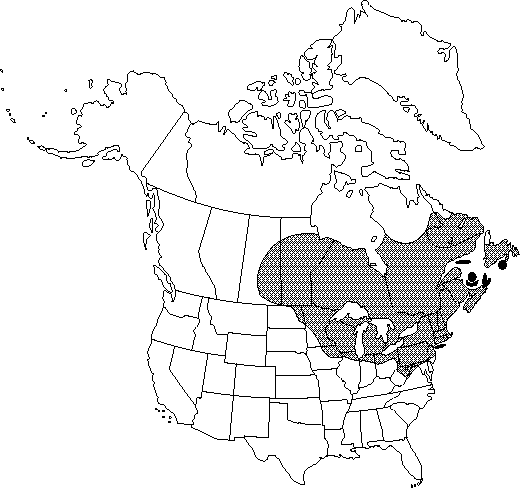Alnus incana subsp. rugosa
Cornell Univ. Agric. Exp. Sta. Mem. 291: 8. 1949.
Shrubs, open, spreading, to 9 m. Bark dark grayish to reddish brown, smooth; lenticels whitish, prominent, horizontal. Winter buds parallel to twig, ellipsoid, 3–7 mm, apex acute or obtuse; stalks 2–4 mm. Leaf blade ovate to elliptic, 4–11 × 3–8 cm, firm, base cuneate to narrowly rounded, margins usually coarsely doubly serrate, toothed to base, apex acute or short-acuminate to slightly obtuse; surfaces abaxially often glaucous, glabrous to sparsely pubescent, often more densely so on veins, slightly to not noticeably resin-coated. Inflorescences: staminate catkins in 1 or more clusters of 2–4, 2–7 cm; pistillate catkins in 1 or more clusters of 2–6. Infructescences ovoid, 1–1.7 × 0.8–1.2 cm; peduncles 1–5 mm. 2n = 28.
Phenology: Flowering early spring.
Habitat: Stream banks, lake shores, bogs, swamps, margins of wet fields, swales, and roadsides, often forming dense thickets
Elevation: 0–800 m
Distribution

St. Pierre and Miquelon, Man., N.B., Nfld. and Labr., N.S., Ont., P.E.I., Que., Sask., Conn., Ill., Ind., Iowa, Maine, Md., Mass., Mich., Minn., N.H., N.J., N.Y., N.Dak., Ohio, Pa., R.I., Vt., Va., W.Va., Wis.
Discussion
Alnus incana subsp. rugosa is an important shoreline and meadow colonizer in boreal and north temperate areas of the Canadian Shield, and a weedy successional species in damp areas along roadsides throughout its range. It overlaps in range and intergrades with A. incana subsp. tenuifolia to the west (in Saskatchewan and Manitoba) and with A. serrulata to the south. It is only slightly differentiated from the more treelike European A. incana subsp. incana.
Selected References
None.